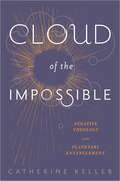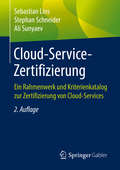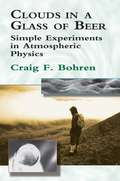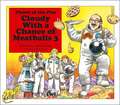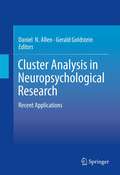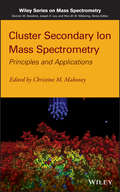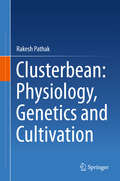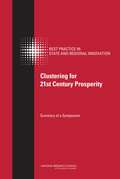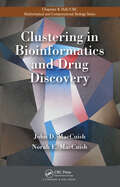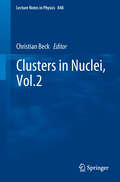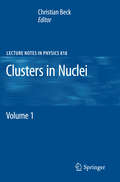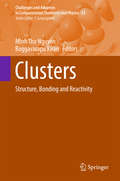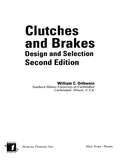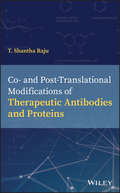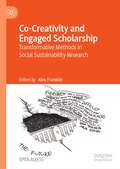- Table View
- List View
Cloud of the Impossible: Negative Theology and Planetary Entanglement
by Catherine KellerCatherine Keller is professor of constructive theology at Drew University. Her work interweaves process relationalism and poststructuralist philosophy with an evolving feminist cosmopolitics. At once constructive and deconstructive in approach, it engages questions of ecological, social, and spiritual practice amidst an irreducible indeterminacy. Among her many books are Apocalypse Now & Then; God and Power; and The Face of the Deep: A Theology of Becoming.
Cloud-Based Remote Sensing with Google Earth Engine: Fundamentals and Applications
by Jeffrey A. Cardille Morgan A. Crowley David Saah Nicholas E. ClintonThis book guides its audience—which can range from novice users to experts— though a 55-chapter tour of Google Earth Engine. A sequenced and diverse set of lab materials, this is the product of more than a year of effort from more than a hundred individuals, collecting new exercises from professors, undergraduates, master’s students, PhD students, postdocs, and independent consultants. Cloud Based Remote Sensing with Google Earth Engine is broadly organized into two halves. The first half, Fundamentals, is a set of 31 labs designed to take the reader from being a complete Earth Engine novice to being a quite advanced user. The second half, Applications, presents a tour of the world of Earth Engine across 24 chapters, showing how it is used in a very wide variety of settings that rely on remote-sensing data This is an open access book.
Cloud-Service-Zertifizierung: Ein Rahmenwerk und Kriterienkatalog zur Zertifizierung von Cloud-Services
by Stephan Schneider Ali SunyaevDie Auslagerung von Services in die Cloud ist mit Risiken verbunden. Dieses Buch liefert ein Rahmenwerk zur Zertifizierung von Services in der Cloud. Herzstück dabei ist ein umfangreicher Kriterienkatalog zum Assessment von Cloud-Services. Dabei wendet sich das Buch an Cloud-Service-Anwender und unterstützt bei der Bewertung, dem Vergleich und der Auswahl von Angeboten. Gerade in kritischen Bereichen wie Sicherheit, Verfügbarkeit und Vertragsfragen unterstützt der Katalog bei der Definition von eigenen Anforderungen. Das Buch eignet sich jedoch auch für Cloud-Service-Anbieter, die es zum Self-Assessment und zur Verbesserung der eigenen Services nutzen können. Das Buch fasst eines der Ergebnisse des dreijährigen Forschungsprojekts ,,Value4Cloud" zusammen, das im Rahmen des Technologieprogramms ,,Trusted Cloud" vom Bundesministerium für Wirtschaft und Technologie gefördert wurde. Es liefert mit 219 Zertifizierungskriterien und einem Zertifizierungsrahmenwerk einen wichtigen Beitrag zum Assessment von Cloud-Services und der Verbesserung von Cloud-Service-Zertifizierungen.
Cloud-Service-Zertifizierung: Ein Rahmenwerk und Kriterienkatalog zur Zertifizierung von Cloud-Services
by Stephan Schneider Ali Sunyaev Sebastian LinsDieses Buch liefert ein Rahmenwerk zur Zertifizierung von Services in der Cloud. Herzstück dabei ist ein umfangreicher Kriterienkatalog zum Assessment von Cloud-Services, der im Forschungsprojekt „Value4Cloud“ , gefördert vom Bundesministerium für Wirtschaft und Technologie, entwickelt wurde. Cloud-Service-Anwender werden bei der Bewertung, dem Vergleich und der Auswahl von Services unterstützt. Das Buch eignet sich auch für Cloud-Service-Anbieter zum Self-Assessment und zur Verbesserung der eigenen Services.
Clouds in a Glass of Beer: Simple Experiments in Atmospheric Physics
by Craig F. BohrenEver wonder why steam rises from a bowl of hot soup or why a greenhouse retains heat? And have you ever puzzled over the real meaning of "once in a blue moon" or why sand is darker when it's wet than when it's dry? And just why, exactly, do bubbles appear in a glass of beer when you add salt to it?These and many other baffling questions are answered in this engaging book by a physics professor at Pennsylvania State University. Ranging from playful to serious, Professor Bohren's lively and entertaining discussions employ a liberal mixture of humor and anecdote to debunk a host of scientific myths and render science lessons thoroughly understandable. Chapters include "On a Clear Day You Can't See Forever," "A Murder in Ceylon." "The Green Flash," "Physics on a Manure Heap," " Indoor Rainbows," and "Multiple Scattering at the Breakfast Table.""The book rings with a unifying tone: the science of the everyday physical world is fun. And so is the book," writes Jearl Walker, a member of the Physics Department at Cleveland State University. Beginning physics and general readers will be fascinated by the scientific knowledge gained from this work; and science teachers will find it a treasure trove of ideas for simple, vivid classroom demonstrations.
Cloudy With a Chance of Meatballs 3: Planet of the Pies
by Judi BarrettWhen astronauts land on Mars, their first discovery is a substance not unlike pie filling, and Kate and Henry are eager to go taste some, but Grandpa, who may have some inside information, discourages them.
Clubroot Disease of Crucifers: Biology, Ecology and Disease Management
by Govind Singh Saharan Prabhu Dayal Meena Naresh K. MehtaThe book is presenting a comprehensive information on fundamental, and applied knowledge of Plasmodiophora brassicae Woronin. infecting cruciferous crops, and weeds. Clubroot of crucifers has spread over more than 88 countries of the world with average annual loss of cruciferous crops from 10-15 per cent at global level. It is considered as a disease of cultivation since once introduced in a field, its inoculum piles up year by year in the form of resilient resting spores of P. brassicae which spreads in the field through field operations. This disease is very unique since the pathogen can survive in the soil in the rhizosphere of non-host plants in addition to its main host cruciferous species, cultivated or wild. This book complies inclusive information about the disease, its geographical distribution, symptoms, host range, yield losses, and disease assessment scales. The book also explores host-parasite interactions in the form of seed infection, disease cycle, process of infection, pathogenesis, epidemiology and forecasting. Chapters discuss the genetic and molecular mechanisms of host-parasite relationships, management practices including cultural, chemical, biological control practices, and other integrated approaches. The book is immensely useful to researchers, teachers, extension specialists, farmers, and all others who are interested to grow healthy and profitable cruciferous crops all over the world. Also the book serves as additional reading material for undergraduate and graduate students of agriculture and especially plant pathology. National and international agricultural scientists, policy makers will also find this to be a useful read.
Clues to the Universe
by Christina LiThis stellar debut about losing and finding family, forging unlikely friendships, and searching for answers to big questions will resonate with fans of Erin Entrada Kelly and Rebecca Stead.The only thing Rosalind Ling Geraghty loves more than watching NASA launches with her dad is building rockets with him. When he dies unexpectedly, all Ro has left of him is an unfinished model rocket they had been working on together.Benjamin Burns doesn’t like science, but he can’t get enough of Spacebound, a popular comic book series. When he finds a sketch that suggests that his dad created the comics, he’s thrilled. Too bad his dad walked out years ago, and Benji has no way to contact him.Though Ro and Benji were only supposed to be science class partners, the pair become unlikely friends, and Ro even figures out a way to reunite Benji and his dad. But Benji hesitates, which infuriates Ro. Doesn’t he realize how much Ro wishes she could be in his place?As the two face bullying, grief, and their own differences, Benji and Ro try to piece together clues to some of the biggest questions in the universe.A Washington Post KidsPost Summer Book Club selection * A Junior Library Guild Selection * A Bank Street Best Book of the Year
Cluster Analysis in Neuropsychological Research: Recent Applications
by Daniel N. Allen Gerald GoldsteinCluster analysis is a multivariate classification technique that allows for identification of homogenous subgroups within diverse samples based on shared characteristics. In recent years, cluster analysis has been increasingly applied to psychological and neuropsychological variables to address a number of empirical questions. This book provides an overview of cluster analysis, including statistical and methodological considerations in its application to neurobehavioral variables. First, an introduction to cluster analysis is presented that emphasizes issues of relevance to neuropsychological research, including controversies surrounding it use. Cluster analysis is then applied to clinical disorders that do not have an associated prototypical neuropsychological profile, including traumatic brain injury, schizophrenia, and health problems associated with homelessness. In a second application, cluster analysis is used to investigate the course of normal memory development. Finally, cluster analysis is applied to classification of brain injury severity in children and adolescents who sustained traumatic brain injury.
Cluster Ion-Solid Interactions: Theory, Simulation, and Experiment
by Zinetula InsepovCluster Ion-Solid Interactions: Theory, Simulation, and Experiment provides an overview of various concepts in cluster physics and related topics in physics, including the fundamentals and tools underlying novel cluster ion beam technology. The material is based on the author's highly regarded courses at Kyoto University, Purdue University, the Mos
Cluster Secondary Ion Mass Spectrometry
by Christine M. MahoneyExplores the impact of the latest breakthroughs in cluster SIMS technology Cluster secondary ion mass spectrometry (SIMS) is a high spatial resolution imaging mass spectrometry technique, which can be used to characterize the three-dimensional chemical structure in complex organic and molecular systems. It works by using a cluster ion source to sputter desorb material from a solid sample surface. Prior to the advent of the cluster source, SIMS was severely limited in its ability to characterize soft samples as a result of damage from the atomic source. Molecular samples were essentially destroyed during analysis, limiting the method's sensitivity and precluding compositional depth profiling. The use of new and emerging cluster ion beam technologies has all but eliminated these limitations, enabling researchers to enter into new fields once considered unattainable by the SIMS method. With contributions from leading mass spectrometry researchers around the world, Cluster Secondary Ion Mass Spectrometry: Principles and Applications describes the latest breakthroughs in instrumentation, and addresses best practices in cluster SIMS analysis. It serves as a compendium of knowledge on organic and polymeric surface and in-depth characterization using cluster ion beams. It covers topics ranging from the fundamentals and theory of cluster SIMS, to the important chemistries behind the success of the technique, as well as the wide-ranging applications of the technology. Examples of subjects covered include: Cluster SIMS theory and modeling Cluster ion source types and performance expectations Cluster ion beams for surface analysis experiments Molecular depth profiling and 3-D analysis with cluster ion beams Specialty applications ranging from biological samples analysis to semiconductors/metals analysis Future challenges and prospects for cluster SIMS This book is intended to benefit any scientist, ranging from beginning to advanced in level, with plenty of figures to help better understand complex concepts and processes. In addition, each chapter ends with a detailed reference set to the primary literature, facilitating further research into individual topics where desired. Cluster Secondary Ion Mass Spectrometry: Principles and Applications is a must-have read for any researcher in the surface analysis and/or imaging mass spectrometry fields.
Clusterbean: Physiology, Genetics and Cultivation (SpringerBriefs in Plant Science)
by Rakesh PathakThis book provides in-depth information on clusterbean, its cultivation, genetic improvement, plant protection measures, management of abiotic stresses, molecular aspects etc. It is divided into seven chapters including an introduction to the crop, prospects, constraints, genetic improvement, variability, application of clusterbean gum and its byproducts, cultivation, plant protection, physiological and abiotic stress aspects, along with related genetic markers and biotechnological advances. Clusterbean (Cyamopsis tetragonoloba (L. ) Taub. ), commonly known as 'guar,' is an important leguminous crop grown for seed, green fodder, vegetable and green manuring in arid and semi-arid regions and has a special commercial role due to the gum content in its seeds. India's arid environment provides ideal agro-climatic conditions for the successful cultivation of clusterbean, as the plant needs little surface water, long-duration sunshine and low relative humidity during the cropping season. India accounts for nearly 82 percent of global clusterbean seed production, making it an important export product. Based on essential industry and market data, the book offers a comprehensive overview of this unique crop, and will be of interest to researchers active in the field of clusterbean breeding.
Clustering for 21st Century Prosperity: Summary of a Symposium
by Charles W. WessnerResponding to the challenges of fostering regional growth and employment in an increasingly competitive global economy, many U. S. states and regions have developed programs to attract and grow companies as well as attract the talent and resources necessary to develop regional innovation clusters. These state and regionally based initiatives have a broad range of goals and increasingly include larger resources commitments, often with a sectoral focus and often in partnership with foundations and universities. Recent studies, however, have pointed out that many of these efforts lack the scale and the steady commitment needed for success. This has prompted new initiatives to coordinate and concentrate investments from a variety of federal agencies to develop research parks, business incubators, and other strategies to encourage entrepreneurships and high-tech development in the nation's regions. Understanding the nature of innovation clusters and public policies associated with successful cluster development is therefore of current relevance. Clustering for 21st Century Prosperity identifies best practices with regard to goals, structures, instruments, modes of operation, synergies across private and public programs, funding mechanisms and levels, and evaluation efforts. The committee, under the Board on Science, Technology, and Economic Policy (STEP) is reviewing selected state and regional efforts to capitalize on federal and state investments in areas of critical national needs. This review includes both efforts to strengthen existing industries as well as specific technology focus areas such as nanotechnology, stem cells, and advanced energy in order to better understand program goals, challenges, and accomplishments. As part of this study, the committee is convening a series of public workshops and symposia involving responsible local, state, and federal officials and other stakeholders. Drawing from discussions at these symposia, fact-finding meetings, and commissioned analyses of existing state and regional programs and technology focus areas, the committee will subsequently produce a final report with findings and recommendations focused on lessons, issues, and opportunities for complementary U. S. policies created by these state and regional initiatives.
Clustering in Bioinformatics and Drug Discovery (Chapman & Hall/CRC Computational Biology Series)
by John David MacCuish Norah E. MacCuishWith a DVD of color figures, Clustering in Bioinformatics and Drug Discovery provides an expert guide on extracting the most pertinent information from pharmaceutical and biomedical data. It offers a concise overview of common and recent clustering methods used in bioinformatics and drug discovery.Setting the stage for subsequent material, the firs
Clusters in Automotive and Information & Communication Technology: Innovation, Multinationalization and Networking Dynamics
by Paul J.J. WelfensInformation & communication technology (ICT) and the automotive sector are two of the most important industries in the EU and the US. The EU's eastern expansion and economic globalization have reinforced competition on the one hand; on the other hand the importance of outsourcing and off-shoring has increased. Against this background the intensification of innovation dynamics becomes crucial - and with them the role of regional innovation clusters. The analysis examines seven regions and six EU countries. The focus is on cluster and network dynamics in both industries, as regional ICT clusters are playing an increasingly central role in many European regions. Specialization and structural change in the automotive sector are highlighted, and new strategic approaches for multinational companies and changes in policy options are identified.
Clusters in Nuclei, Vol.2 (Lecture Notes in Physics #848)
by Christian BeckFollowing the pioneering discovery of alpha clustering and of molecular resonances, the field of nuclear clustering is today one of those domains of heavy-ion nuclear physics that faces the greatest challenges, yet also contains the greatest opportunities. After many summer schools and workshops, in particular over the last decade, the community of nuclear molecular physicists has decided to collaborate in producing a comprehensive collection of lectures and tutorial reviews covering the field. This second volume follows the successful Lect. Notes Phys. 818 (Vol.1), and comprises six extensive lectures covering the following topics: Microscopic cluster models Neutron halo and break-up reactions Break-up reaction models for two- and three-cluster projectiles Clustering effects within the di-nuclear model Nuclear alpha-particle condensates Clusters in nuclei: experimental perspectives By promoting new ideas and developments while retaining a pedagogical style of presentation throughout, these lectures will serve as both a reference and an advanced teaching manual for future courses and schools in the fields of nuclear physics and nuclear astrophysics.
Clusters in Nuclei, Volume 3 (Lecture Notes in Physics #875)
by Christian BeckFollowing the pioneering discovery of alpha clustering and of molecular resonances, the field of nuclear clustering is today one of those domains of heavy-ion nuclear physics that faces the greatest challenges, yet also contains the greatest opportunities. After many summer schools and workshops, in particular over the last decade, the community of nuclear molecular physicists has decided to collaborate in producing a comprehensive collection of lectures and tutorial reviews covering the field. This third volume follows the successful Lect. Notes Phys. 818 (Vol. 1) and 848 (Vol. 2), and comprises six extensive lectures covering the following topics: - Gamma Rays and Molecular Structure - Faddeev Equation Approach for Three Cluster Nuclear Reactions - Tomography of the Cluster Structure of Light Nuclei Via Relativistic Dissociation - Clustering Effects Within the Dinuclear Model : From Light to Hyper-heavy Molecules in Dynamical Mean-field Approach - Clusterization in Ternary Fission - Clusters in Light Neutron-rich Isotopes By promoting new ideas and developments while retaining a pedagogical style of presentation throughout, these lectures will serve as both a reference and an advanced teaching manual for future courses and schools in the fields of nuclear physics and nuclear astrophysics.
Clusters in Nuclei: Volume 1 (Lecture Notes in Physics #818)
by Christian BeckFollowing the pioneering discovery of alpha clustering and of molecular resonances, the field of nuclear clustering is presently one of the domains of heavy-ion nuclear physics facing both the greatest challenges and opportunities. After many summer schools and workshops, in particular over the last decade, the community of nuclear molecular physics decided to team up in producing a comprehensive collection of lectures and tutorial reviews covering the field. This first volume, gathering seven extensive lectures, covers the follow topics: * Cluster Radioactivity * Cluster States and Mean Field Theories * Alpha Clustering and Alpha Condensates * Clustering in Neutron-rich Nuclei * Di-neutron Clustering * Collective Clusterization in Nuclei * Giant Nuclear Molecules By promoting new ideas and developments while retaining a pedagogical nature of presentation throughout, these lectures will both serve as a reference and as advanced teaching material for future courses and schools in the fields of nuclear physics and nuclear astrophysics.
Clusters – Contemporary Insight in Structure and Bonding (Structure and Bonding #174)
by Stefanie DehnenChemical structure and bonding. The scope of the series spans the entire Periodic Table and addresses structure and bonding issues associated with all of the elements. It also focuses attention on new and developing areas of modern structural and theoretical chemistry such as nanostructures, molecular electronics, designed molecular solids, surfaces, metal clusters and supramolecular structures. Physical and spectroscopic techniques used to determine, examine and model structures fall within the purview of Structure and Bonding to the extent that the focus is on the scientific results obtained and not on specialist information concerning the techniques themselves. Issues associated with the development of bonding models and generalizations that illuminate the reactivity pathways and rates of chemical processes are also relevant. The individual volumes in the series are thematic. The goal of each volume is to give the reader, whether at a university or in industry, a comprehensive overview of an area where new insights are emerging that are of interest to a larger scientific audience.
Clusters: Structure, Bonding and Reactivity (Challenges and Advances in Computational Chemistry and Physics #23)
by Minh Tho Nguyen Boggavarapu KiranThe field of atomic clusters continues to attract great interest amongst physicists and chemists alike. This is in part due to their intrinsic properties and potential industrial applications. The first part of Binary Clusters is devoted to recent developments in experimental techniques, the second part covers a variety of theoretical approaches. Different theoretical methods based on group/graph theories and quantum chemical computational methods as well as various spectroscopy techniques (such as mass, laser, infrared, photoelectron etc. ) are applied to the determination of the existence of geometrical and electronic structures, chemical bonding phenomena, and the thermodynamic stabilities of several classes of binary clusters. All chapters within this review volume have been contributed by experts in chemistry, physics, and material sciences based at the University of Leuven, Belgium. This book is aimed at professionals and students working in cluster science.
Clutches and Brakes: Design and Selection
by William C. OrthweinConveniently gathering formulas, analytical methods, and graphs for the design and selection of a wide variety of brakes and clutches in the automotive, aircraft, farming, and manufacturing industries, Clutches and Brakes: Design and Selection, Second Edition simplifies calculations, acquaints engineers with an expansive range of application, and a
Co- and Post-Translational Modifications of Therapeutic Antibodies and Proteins
by T. Shantha RajuA Comprehensive Guide to Crucial Attributes of Therapeutic Proteins in Biological Pharmaceuticals With this book, Dr. Raju offers a valuable resource for professionals involved in research and development of biopharmaceutical and biosimilar drugs. This is a highly relevant work, as medical practitioners have increasingly turned to biopharmaceutical medicines in their search for safe and reliable treatments for complex diseases, while pharmaceutical researchers seek to expand the availability of biopharmaceuticals and create more affordable biosimilar alternatives. Readers receive a thorough overview of the major co-translational modifications (CTMs) and post-translational modifications (PTMs) of therapeutic proteins relevant to the development of biotherapeutics. The majority of chapters detail individual CTMs and PTMs that may affect the physicochemical, biochemical, biological, pharmacokinetic, immunological, toxicological etc. properties of proteins. In addition, readers are guided on the methodology necessary to analyze and characterize these modifications. Thus, readers gain not only an understanding of CTMs/PTMs, but also the ability to design and assess their own structure-function studies for experimental molecules. Specific features and topics include: Discussion of the research behind and expansion of biopharmaceuticals Twenty chapters detailing relevant CTMs and PTMs of proteins, such as glycosylation, oxidation, phosphorylation, methylation, proteolysis, etc. Each chapter offers an introduction and guide to the mechanisms and biological significance of an individual CTM or PTM, including practical guidance for experiment design and analysis An appendix of biologic pharmaceuticals currently on the market, along with an assessment of their PTMs and overall safety and efficacy This volume will prove a key reference on the shelves of industry and academic researchers involved in the study and development of biochemistry, molecular biology, biopharmaceuticals and proteins in medicine, particularly as biopharmaceuticals and biosimilars become ever more prominent tools in the field of healthcare.
Co-Creativity and Engaged Scholarship: Transformative Methods in Social Sustainability Research
by Alex FranklinThis open access book explores creative and collaborative forms of research praxis within the social sustainability sciences. The term co-creativity is used in reference to both individual methods and overarching research approaches. Supported by a series of in-depth examples, the edited collection critically reviews the potential of co-creative research praxis to nurture just and transformative processes of change. Included amongst the individual chapters are first-hand accounts of such as: militant research strategies and guerrilla narrative, decolonial participative approaches, appreciative inquiry and care-ethics, deep-mapping, photo-voice, community-arts, digital participatory mapping, creative workshops and living labs. The collection considers how, through socially inclusive forms of action and reflection, such co-creative methods can be used to stimulate alternative understandings of why and how things are, and how they could be. It provides illustrations of (and problematizes) the use of co-creative methods as overtly disruptive interventions in their own right, and as a means of enriching the transformative potential of transdisciplinary and more traditional forms of social science research inquiry. The positionality of the researcher, together with the emotional and embodied dimensions of engaged scholarship, are threads which run throughout the book. So too does the question of how to communicate sustainability science research in a meaningful way.
Co-Evolution of Nature and Society: Foundations for Interdisciplinary Sustainability Studies
by Jens JetzkowitzThis book offers support for interdisciplinary research on the interactions of nature and society. It is based on the hypothesis that a science of coevolution is needed to explore paths to a sustainable future. Jens Jetzkowitz initially discusses why social science knowledge only rarely finds its way into sustainability discourse. One significant issue is a view of science that separates knowing and acting, and the book illustrates current problems in conceptualising interdisciplinary knowledge production. It then goes one step further and introduces a workable alternative concept, taking philosophical pragmatism as a point of departure. Sustainable development goals and transdisciplinarity are currently subject to widespread discussions and Jetzkowitz takes a stance on the debates from the perspective of coevolutionary science.This book will appeal to scholars and students interested in environmental and sustainability discourses and to anyone willing to think outside the box.
